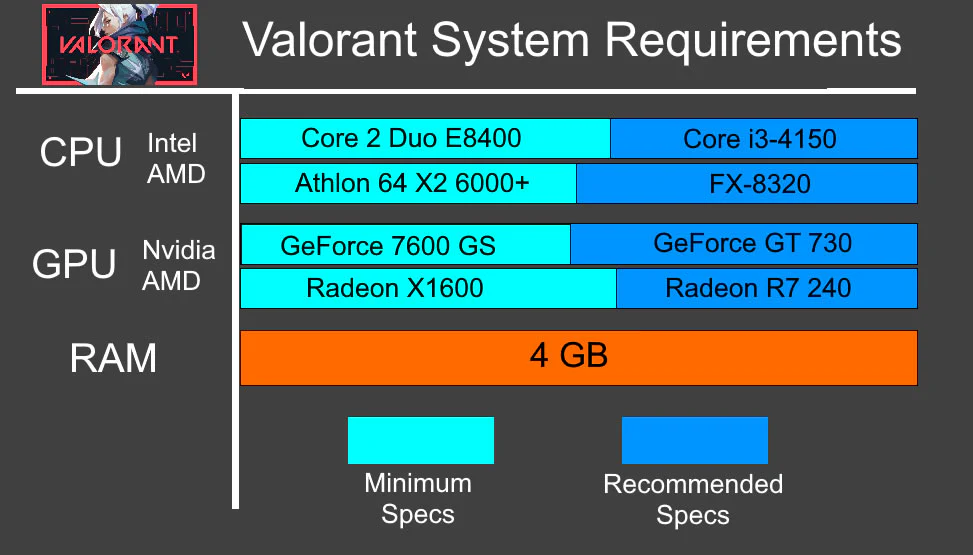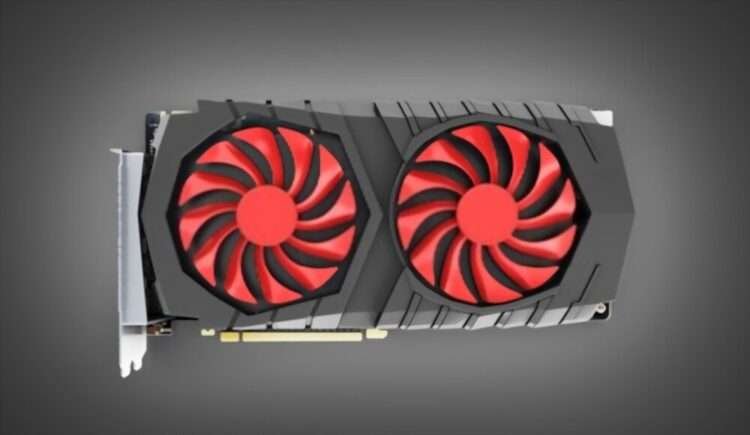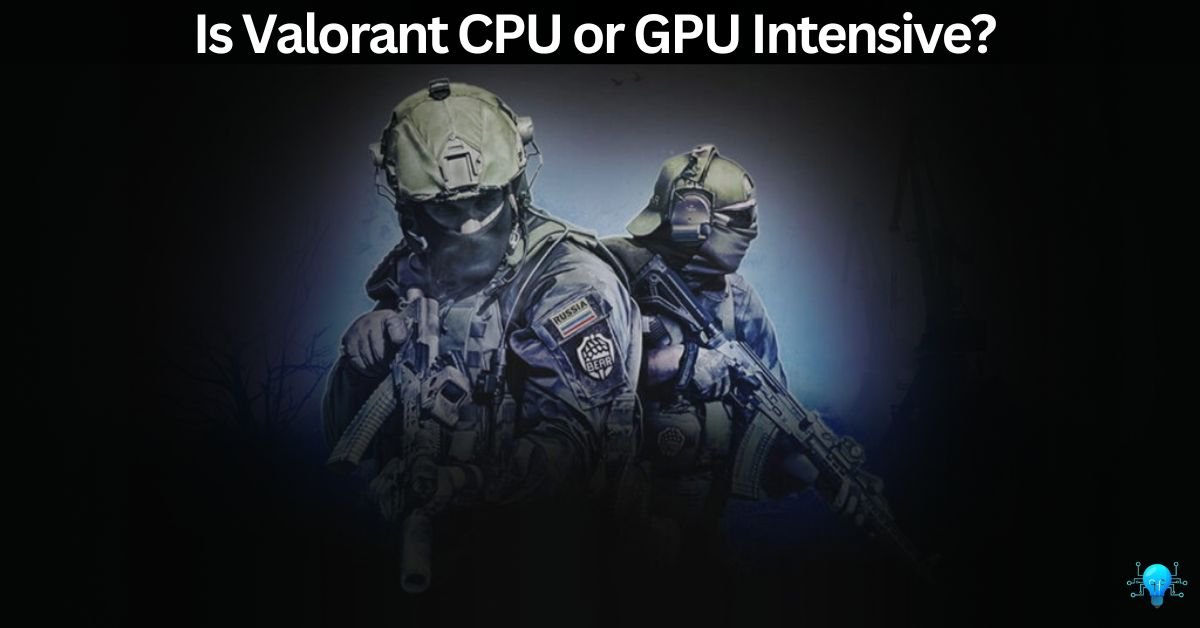Valorant is more CPU intensive, focusing on game logic, physics calculations, and AI interactions, while maintaining balanced GPU requirements for visual clarity and performance.
Do you want a detailed guide? Let’s Step into it then!
Let’s Clear the Basics Firstly:
What Is Valorant?
Valorant is a popular first-person shooter game developed by Riot Games. It combines tactical shooting elements with unique character abilities, creating an engaging and competitive gaming experience. Players must use strategy, teamwork, and skill to succeed in various game modes.
If you want to know about Do You Plug HDMI into GPU or Motherboard? click the link for more information.
What Does It Mean By Being GPU Intensive or CPU Intensive?
A game is considered GPU intensive if it relies heavily on the graphics processing unit (GPU) for rendering graphics and visual effects.

Conversely, a CPU intensive game requires significant processing power from the central processing unit (CPU) to handle tasks such as physics calculations, game logic, and AI.
What Specifications of Valorant Make It More CPU Intensive? – Major 4 WHYs!
1. Detailed Physics Calculations:
First Of All, Valorant incorporates intricate physics calculations to simulate realistic interactions between characters and the game environment. These calculations require significant processing power from the CPU to ensure smooth gameplay and accurate movements.
2. Complex AI Interactions
Secondly, The game’s artificial intelligence (AI) system in Valorant is designed to provide challenging opponents with dynamic behaviors. This complexity demands robust CPU performance to handle AI decision-making processes in real-time during gameplay.
3. Rapid Data Processing
The Next Thing here is that, Valorant operates with a high data processing speed to maintain low latency and responsive gameplay. This rapid processing of game data, including player actions and environmental changes, relies heavily on the CPU’s capability to execute commands swiftly.
4. Game Logic and Mechanics
Critical game logic and mechanics, such as weapon mechanics, ability activations, and match rules enforcement, are managed by the CPU. The CPU-intensive nature of these tasks ensures that gameplay mechanics operate smoothly and consistently for all players.
These specifications collectively contribute to Valorant’s dependency on CPU performance, emphasizing the need for a capable processor to achieve optimal gaming performance. Also, For Further Details, You can Check Reddit and proceed to it as well!
Check out this informative article: What Is Normal GPU Usage While Gaming?
What If I Put GPU Instead of CPU for Valorant?
If you prioritize the GPU over the CPU for Valorant, you might not see a significant performance improvement, as the game relies more on the CPU for critical functions. While a powerful GPU can enhance visual quality, upgrading the CPU might be more beneficial for overall performance in Valorant.
How Much GPU Utilization Will Be Normal for Valorant
Normal GPU utilization for Valorant typically ranges from 30% to 60%, depending on the system’s specifications and the game’s settings. You can also check the details here “How Much GPU Should A Game Use?” Or “What Is Normal GPU Usage While Gaming?” Lower-end systems might see higher utilization, while more powerful setups could have lower GPU usage, reflecting the game’s CPU-bound nature.
How Can We Make Valorant Game To Be GPU Bound? – Play On GPU Storage!
Adjust Graphics Settings
- Increase Texture Quality: Set textures to higher resolutions for better visual fidelity.
- Enable Anti-Aliasing: Smooth out jagged edges by enabling anti-aliasing options.
- Turn On Anisotropic Filtering: Enhance texture detail at oblique angles for a sharper image.
Increase The game’s resolution can increase GPU workload:
- Select Higher Resolutions: Choose resolutions like 1440p or 4K for more detailed visuals.
- Monitor Frame Rates: Ensure your GPU can handle higher resolutions without compromising frame rates.
Enable Visual Effects
- Turn On Ambient Occlusion: Enhance shadow and lighting effects for more realistic scenes.
- Use Depth of Field: Blur background elements to focus on in-game action.
- Activate Motion Blur: Add motion blur effects for smoother animations during fast-paced moments.
Overclock Your GPU
- Use GPU Overclocking Software: Adjust GPU core and memory clocks for higher processing speeds.
- Monitor Temperatures: Ensure your GPU stays within safe temperature ranges while overclocking.
Upgrade GPU Hardware
- Research Compatible GPUs: Choose a GPU that meets Valorant’s recommended system requirements.
- Install the GPU: Replace or install the new GPU in your computer following manufacturer instructions.
- Update Drivers: Download and install the latest GPU drivers to ensure compatibility and performance optimizations.
Optimize System Configuration
Optimize your system configuration to maximize GPU performance:
- Close Background Applications: Free up system resources by closing unnecessary programs.
- Use Performance Mode: Set your computer to high-performance mode in power settings.
- Check for System Updates: Update your operating system and drivers for stability and compatibility.
Lastly, Monitor Performance
- Use In-Game Performance Metrics: Check frame rates, GPU utilization, and temperatures.
- Benchmark and Compare: Run benchmarks to evaluate performance improvements after adjustments.
By following these steps, you can potentially make Valorant more GPU bound, enhancing visual quality and overall gaming experience based on your system’s capabilities.
What’s Beneficial for a Game, To Be GPU Intensive or CPU Intensive?
Whether it’s more beneficial for a game to be GPU or CPU-intensive depends on the game’s design and the target audience. GPU-intensive games often offer richer graphics and more immersive visual experiences.

On the other hand, CPU-intensive games might focus on complex game mechanics and AI, providing depth in gameplay. Balancing both aspects is ideal for a comprehensive gaming experience.
How Valorant is Different from Other Games and Apps That Are GPU Intensive
- Optimized Performance: Valorant prioritizes smooth gameplay over high-end graphics.
- Low Latency Focus: Emphasizes low latency for competitive advantage.
- Minimalist Visual Design: Uses clear visuals for easy identification of game elements.
- Balanced Hardware Requirements: Designed to run well on a wide range of systems.
- Focused on Competitive Gameplay: Combines tactical shooting with unique character abilities.
How Do You Know If a Game Is CPU or GPU Intensive?
So, I guess, I’ve missed an explanation of how to recognize whether this system of GPU bound or CPU Bound. That’s why To determine if a game is CPU or GPU intensive, monitor the usage of both components while playing. High CPU usage indicates the game is CPU intensive, while high GPU usage signifies a GPU-intensive game. Tools like Task Manager or third-party software can help in monitoring these metrics.
Shall I Optimize the CPU Performance to Have a Smooth Gameplay of Valorant?
Yes, optimizing CPU performance can lead to smoother gameplay in Valorant. Closing background applications, upgrading the CPU, and ensuring proper cooling can enhance performance. Adjusting in-game settings to reduce CPU load can also help.
Can’t I Make Valorant Both CPU and GPU Intensive?
While it’s challenging to make Valorant equally CPU and GPU intensive, balancing settings can distribute the workload more evenly. Increasing graphical settings can shift some load to the GPU, but the game’s core mechanics will still rely on the CPU.
Which Gpu Will Be Best For Valorant Game By The Way?
For playing Valorant smoothly, a mid-range GPU like the NVIDIA GTX 1660 or AMD RX 580 would be sufficient. These GPUs offer good performance at 1080p resolution with high frame rates, meeting the game’s requirements without overspending on higher-end models.
To check whether AMD is best for Valorant Game, Click the link here.
Some Other Alternatives Of Valorant
Is Call of Duty (COD) CPU or GPU Intensive?
Call of Duty (COD) games typically prioritize GPU performance for high-end graphics and visual effects, making them more GPU intensive. However, they also require a capable CPU for handling game logic and AI computations.
Is Counter-Strike: Global Offensive (CS) CPU or GPU Intensive?
CS leans more towards CPU intensity due to its focus on fast-paced gameplay, precise aiming mechanics, and responsive character movements. While it benefits from a strong GPU for graphics, CPU performance is crucial for optimal gameplay.
Is Virtual Reality (VR) CPU or GPU Intensive?
Virtual Reality (VR) experiences vary but generally demand significant GPU power for rendering immersive environments in real-time. The CPU also plays a vital role in processing game logic and maintaining smooth VR interactions.
Is BeamNG.drive CPU or GPU Intensive?
BeamNG.drive is highly CPU intensive as it simulates realistic vehicle physics and interactions. The game’s advanced physics engine relies heavily on CPU calculations to maintain accuracy and responsiveness.
Is Escape from Tarkov GPU or CPU Intensive?
Escape from Tarkov is both CPU and GPU intensive. It requires a strong CPU for processing complex game mechanics, AI behaviors, and server interactions. Meanwhile, the GPU handles rendering detailed environments and visual effects.
Is Elden Ring GPU Intensive?
Elden Ring is expected to be GPU intensive, focusing on high-quality graphics and expansive open-world environments. A capable GPU will be necessary to experience the game’s visual richness and smooth performance.
Is Roblox CPU or GPU Intensive?
Roblox is primarily CPU intensive due to its focus on processing dynamic game worlds, scripting, and multiplayer interactions. While a decent GPU can enhance visual quality, CPU performance is critical for overall gameplay smoothness.
Recent Post: Is 53c GPU Temp Good – Let’s Find Out Together!
Some Related Queries:
Does Valorant Use 100% GPU?
No, Valorant typically does not use 100% GPU due to its CPU-intensive nature. It relies more on CPU performance, with GPU usage varying based on graphical settings and system specifications.
Can I Improve Valorant Performance by Upgrading Both My CPU and GPU?
Yes, upgrading both the CPU and GPU can improve Valorant’s performance. A stronger CPU will handle the game’s demands better, while an upgraded GPU can enhance visual quality.
How Much GPU Utilization Is Normal?
Normal GPU utilization for Valorant ranges from 30% to 60%, depending on your system and settings.
Who Can Play Valorant?
Valorant is designed for players of all skill levels, from casual gamers to competitive players. It requires strategic thinking, teamwork, and quick reflexes.
What Kind of Graphics Does Valorant Game Use?
Valorant uses stylized graphics with a focus on clarity and performance. The game’s visuals are designed to ensure smooth gameplay and easy identification of enemies and objectives.
Is Valorant Too Heavy for GPU?
No, Valorant is not too heavy for the GPU. It’s optimized to run well on a wide range of systems, with more emphasis on CPU performance.
How To Play Valorant With GPU Only?
It’s not possible to play Valorant with GPU only, as the game requires significant CPU resources for core functions like physics calculations and game logic.
To Sum Up:
Understanding whether Valorant is CPU or GPU-intensive helps optimize your gaming setup for the best performance. While Valorant leans towards being more CPU intensive, balancing your system’s resources can lead to a smoother and more enjoyable gaming experience.

